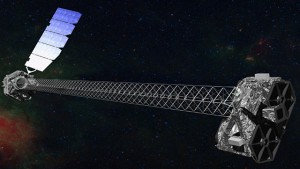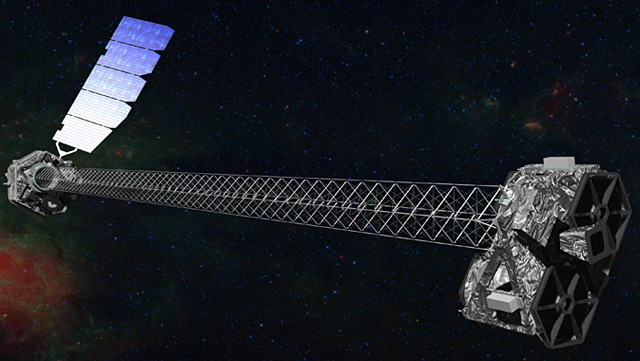“Well, we’re not actually seeing the black hole. That’s a common misconception. What you’re actually seeing is the stuff that’s attracted to it,” says Harrison.
What is a Black Hole?
“Theoretically, black holes are really quite simple,” says Alex Filippenko, an astronomy professor at UC Berkeley.
To explain them, he uses a not-so-scientific source: the 1979 Disney movie “The Black Hole.” “It’s a sci-fi movie that has these crewmembers go into a black hole while they’re in a spaceship.”
In one clip, the crew’s spaceship gets closer to the center of the black hole and they’re inescapably pulled in. Filippenko says that part is true. They’re being drawn in by gravity. “Gravity is enormously important. You can say it’s the sculptor of the universe.”
Throw a tennis ball here on Earth and it falls back to the ground. But shoot a rocket into space and it escapes the planet’s gravity, no problem. That’s because, in the grand scheme of things, the Earth isn’t very big or dense.
Black holes, on the other hand, form from much bigger objects. When a massive star explodes, the core collapses down into a tiny point.
“Matter has been compressed so much, that the gravity around it has become really, really strong,” says Filippenko. “Not even light can escape.”
From here on out, though, the movie gets a few things wrong. The crew flies through the black hole, emerging unscathed into another universe.
“No, I don’t think so. There are all kinds of ways in which you would die a horrible death,” says Filippenko. For one, gravity would rip you apart. “We say that you would be ‘spaghetti-fied.”
But there’s another problem. Black holes pull in tons of gas and dust, just like water going down a drain. It swirls faster and faster and gets hotter and hotter. “You would be zapped. You would be vaporized by all the radiation coming from this hot disc of material swirling in,” says Filippenko.
The NuStar telescope will be looking for this swirling material. It emits x-ray light, like the kind you find in a doctor’s office. The x-ray images from NuStar will be 10 times crisper than captured ever before.
Black Hole Mysteries
Scientists are hoping this will give them more clues about the mysteries surrounding black holes – like how they grow.
“They eat dramatically but rarely,” says Eliot Quataert, astronomy professor at UC Berkeley. He says black holes grow just like we do – by eating. There are millions of black holes around our galaxy, but at the very center, there’s a supermassive black hole that’s eaten quite a bit.
“The misconception that’s out there a little is that black holes are a vacuum cleaner that will inevitably suck in everything around them,” says Quataert. For the most part, black holes are on a forced diet. They’ve already eaten everything close by.
“But then every once in a while, there will be a lot of gas that gets funneled to the center of a galaxy and the black hole will grow in a big spurt.”
Quataert says seeing this black hole mealtime with the NuStar telescope could reveal more about the extreme physics behind it. That, in turn, can answer questions about how galaxies and solar systems form -- essentially, why our little planet is here at all.
“These are conditions that you can’t reproduce anywhere on Earth, so they provide a window into physics that you can’t study in any other way,” says Quataert.
Black Hole Belches
The NuStar telescope will also be looking for a strange phenomenon – something made famous by Homer Simpson: burps.
“You can think about this black hole burping as if you’re on a feeding frenzy and you can’t fit that many hot dogs in your mouth,” says Joshua Bloom, an associate professor at UC Berkeley.
Early last year, astronomers noticed a star that had wandered too close to a black hole. “You would see the star getting pulled apart almost like taffy,” he says.
As it devoured the star, the black hole spit out a huge jet of material – a burp. That might sound weird. Nothing can escape a black hole, right?
“You’re right. These are sort of the Las Vegas of the universe – what happens in a black hole stays inside of a black hole. But on the outskirts of them, that is where there’s tremendous action,” says Bloom.
So far, astronomers haven’t observed many of these burps and they aren’t exactly sure why they happen. Bloom has his fingers crossed that the NuStar telescope will see more of them. “We are really on the receiving end of this grand experiment in the universe. The real hope is that we find something that hasn't been envisioned yet.”

